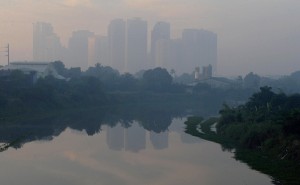AIR pollution in Metro Manila has worsened because of the firecrackers and pyrotechnics exploded by New Year revelers, according to the Department of Environment and Natural Resources (DENR).
DENR Secretary Ramon Paje said the number of particulates in the air went beyond the guideline values set by the government and the World Health Organization.
On the first day of the year, the average reading for particulate matter with size of 10 microns or PM10 in Metro Manila was 1,437 ug/Ncm (micrograms per normal cubic meter of air), compared to 537 ug/Ncm last year.
Paje said the hourly maximum levels of PM10 in various cities exceeded the air quality guideline value of 150 ug/Ncm, particularly in Katipunan Avenue (1,990 ug/Ncm) EDSA-Timog (1,450 ug/Ncm), Valenzuela City (1,160 ug/Ncm), and Taguig City (1,150 ug/Ncm).
When lit, firecrackers release a large amount of tiny toxic particles that can easily enter the lungs and damage the respiratory system. They also emit smoke that contains sulphur compounds and heavy metals that could trigger asthma attacks or cause other ailments.
Firecrackers also make water acidic, deplete nutrients in the soil and affect the diversity of the ecosystems, Paje said.
Climate Change Commissioner Heherson Alvarez said firecrackers should be banned because they endanger people’s health and the environment.
“The DOH statistics do not tell us the number of revellers and innocent bystanders- including infants, pregnant women, elderly and household pets- whose health is adversely affected as a result of the chemical haze and air pollution caused by firecrackers and pyrotechnics,” he said.
“Pyrotechnics and the mentality that promotes it aggravate global warming, to say nothing of its more perilous impact: the irreversible damage to our natural ecosystems and, ultimately, to our planet,” Alvarez said.
“When I was Environment Secretary in 2001, that agency recorded a 2,000 percent hike in Metro Manila’s carbon dioxide and nitrogen dioxide emissions as a result of massive New Year explosions. Today, with at least 50 percent of the nation’s 100 million people residing in urban areas, I would not be surprised if after 12 years, there is another 2,000 percent increase in greenhouse gas emissions,” Alvarez added.
He said the Philippines is in a unique position “of leading the world in the voluntary banning of firecrackers and pyrotechnics as part of a protective effort to save humanity and our habitat for integration in the 2015 protocol deliberations.”
Paje said the DENR is mainly responsible for the implementation of Republic Act 8749 or the Clean Air Act, but other government agencies as well as strong public support must come together to reduce air pollution.
Malacañang on Thursday called on all stakeholders to come up with a “common stand” on safer alternatives for celebrating New Year.
Presidential Communications Secretary Herminio Coloma Jr. issued the statement after the number of revelry-related injuries rose to more than 800. Coloma said there should be a concerted effort to enact ordinances or national laws that restrict the sale of fireworks.
“Every New Year’s Day, we are greeted with headlines on hundreds of injured persons as a result of firecracker explosions, as well as casualties from stray bullets. We believe that there should be an alternative to this unfortunate scenario,” he said.
“We can ill-afford to wait for another New Year’s Day celebration marred by similar injuries or deaths. We call on all stakeholders to reach a common stand on safer alternatives for celebrating New Year’s Day through local ordinances or enactment and amendment of existing national laws,” he added.


